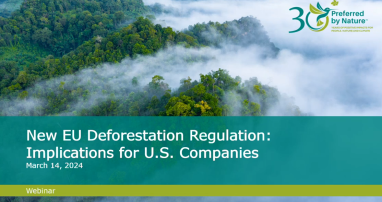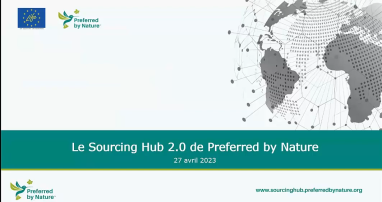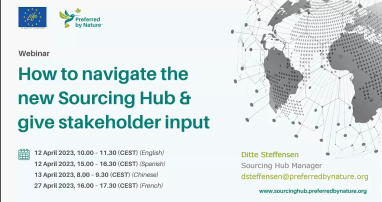Jump to a specific section:
- What is the EUDR
- Is the EUDR applicable to me
- When do I need to be ready?
- Which commodities are in the EUDR's scope?
- Which products are covered by the EUDR?
- Are any products exempted from the EUDR?
Kas ir EUDR?
2023. gada 29. jūnijā Eiropas Savienībā stājās spēkā jauns tiesību akts, kas aizliedz uzņēmumiem laist ES tirgū vai eksportēt no ES preces, kas saistītas ar atmežošanu un mežu degradāciju.
Šis likums tika pieņemts, reaģējot uz to, ka mežu izciršana lauksaimniecības vajadzībām un mežu degradācija veicina klimata pārmaiņas, bioloģiskās daudzveidības samazināšanos un citas vides problēmas:

No 1990. līdz 2020. gadam atmežošanas dēļ tika zaudēti 420 miljoni hektāru mežu. (FAO).

Proti, 23 % antropogēno siltumnīcefekta gāzu emisiju rada tādas darbības kā lauksaimniecība un mežsaimniecība, bet 12 % - lauksaimnieciskā ražošana, tostarp lopkopība un mēslošana (IPCC).

Atmežošana vien rada aptuveni 11% siltumnīcefekta gāzu emisiju (IPCC).
ES Atmežošanas regula: šī regula cenšas samazināt ES ietekmi uz pasaules mežu izzušanu, samazināt siltumnīcefekta gāzu emisijas un aizsargāt bioloģisko daudzveidību, veicinot tādu produktu ražošanu, kuru procesos netiek veikta atmežošana.
Vai EUDR attiecas uz Jums?
EUDR attiecas uz tirgus dalībniekiem vai tirgotājiem, kas pērk un pārdod attiecīgās preces (vai produktus, kas tās satur vai ir izgatavoti no tām), tostarp soju, liellopu gaļu, palmu eļļu, koksni, kakao, kafiju un dabisko kaučuku.
Jums jāspēj pierādīt, ka šo produktu izcelsme nav no nesen atmežotām zemēm vai, ka tie neveicina mežu degradāciju.
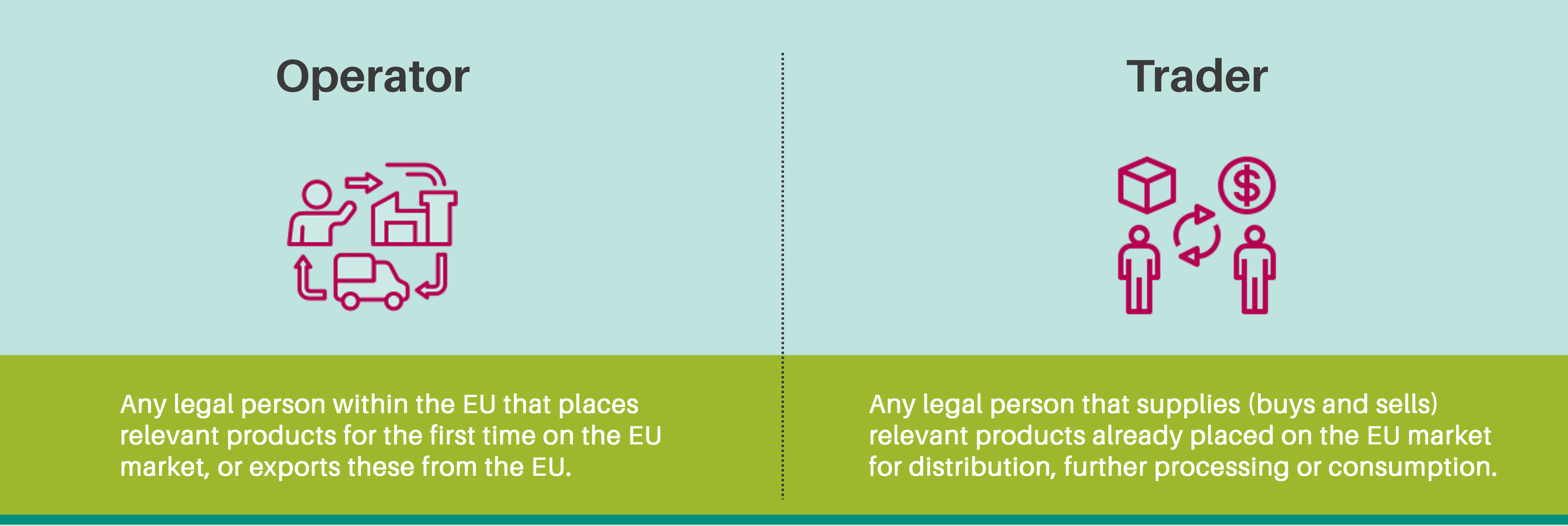
Ražotājiem un lielajiem tirgotājiem ir juridiska atbildība pierādīt, ka šo produktu izcelsme nav no nesen atmežotām zemēm un ka tie neveicina mežu degradāciju (no koksnes iegūtu vai to saturošu produktu gadījumā).
Vai neesat pārliecināts, ka EUDR attiecas uz Jūsu uzņēmumu? Izmantojiet mūsu pašnovērtējuma rīku, kurš šobrīd ir pieejams angļu, franču, vācu un spāņu valodās (tuvākajā laikā rīks būs pieejams arī citās valodās), lai palīdzētu Jums noteikt Jūsu pienākumus saskaņā ar regulu. Saistībā ar mūsu apņemšanos nepārtraukti veikt uzlabojumus, mēs esam pilnveidojuši un papildinājuši sākotnējo versiju, lai piedāvātu Jums mūsu pašnovērtējuma rīka 2.0 versiju.
>> Piekļuve mūsu EUDR tvēruma rīkam V2.0
Kad Jums jābūt gataviem?
Lielākajai daļai uzņēmumu ir jāizpilda regulā noteiktie pienākumi līdz 2024. gada 30. decembrī (piemērošanas datums). Tomēr dažiem uzņēmumiem tiks piemērots pagarināts atbilstības termiņš līdz 2025. gada 30. jūnijam. Šo pagarinājumu piemēros šādi:
| Uz pagarinājumu var pretendēt ražotāji, kas līdz 2020. gada 30. decembrim ir dibināti kā mazie uzņēmumi vai mikrouzņēmumi (kā noteikts regulā). | Šis pagarinājums attiecas uz visiem attiecīgajiem izstrādājumiem, kas uzskaitīti EUDR 1. pielikumā, izņemot koksnes izstrādājumus, uz kuriem jau attiecas EUTR. Citiem vārdiem sakot, nav izņēmuma attiecībā uz izstrādājumiem, uz kuriem pašlaik attiecas EUTR. |
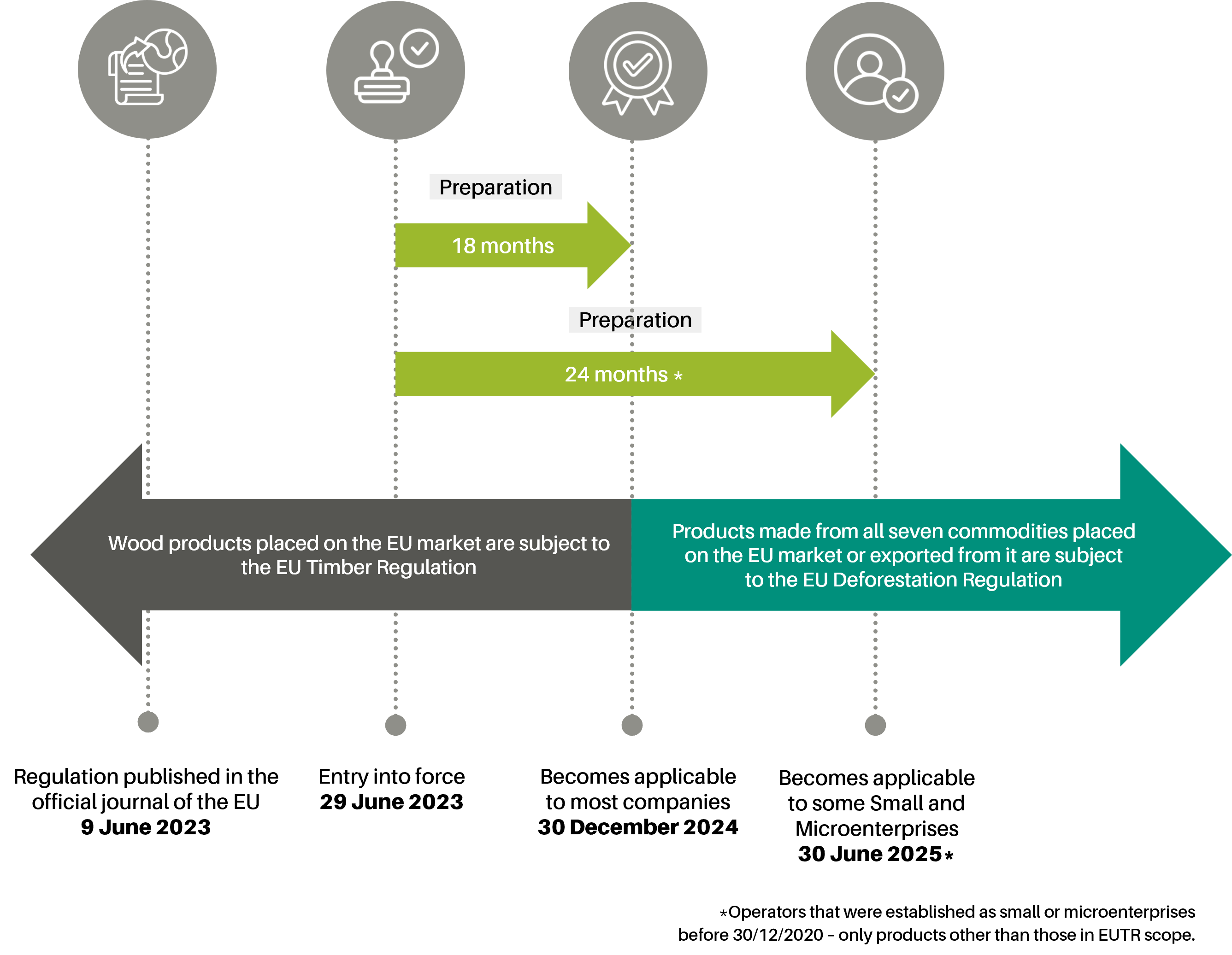
ES Koksnes regula (EUTR) tiks aizstāta ar EUDR tiklīdz tā tiks piemērota 30. Decembrī, 2024. Tomēr koksnes izstrādājumiem EUTR joprojām tiks piemērots trīs gadus, ja:
- Koki tika nocirsti pirms EUDR stāšanās spēkā (pirms 2023. gada 29 jūnija) un,
- Koksnes izstrādājumi tiek laisti ES tirgū EUDR piemērošanas dienā vai pēc tās (30 Decembris, 2024).
Kuras preces ietilpst EUDR darbības jomā?
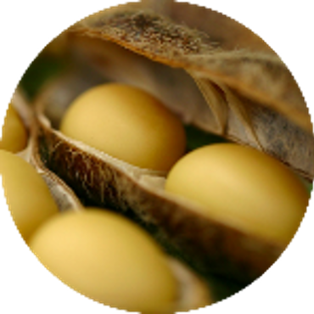
| 
| 
| 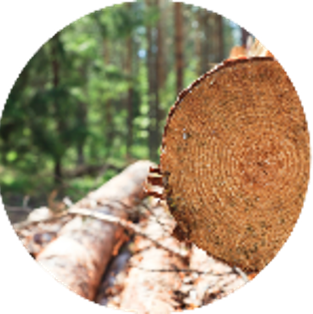
| 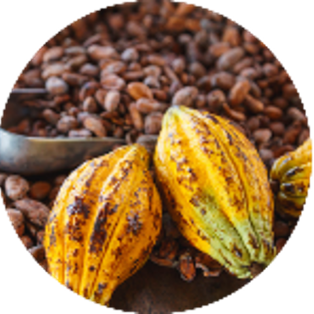
| 
| 
|
EUDR ir vērsta uz septiņām precēm, kuras ES uzskata par svarīgām saistībā ar reģiona patēriņa apjomu un atmežošanas risku: soju, liellopiem, eļļas palmām, koksni, kakao, kafiju un dabisko kaučuku.
Kurus produktus nosedz EUDR?
Katras attiecīgās preces ietvaros regulā ir noteikts, uz kuriem produktiem saskaņā ar ES muitas kodu sarakstu attiecas regulas darbības joma. 1. Pielikumā ir uzskaitīti produktu muitas kodi katrai attiecīgajai precei.
Tas nozīmē, ka jebkurš produkts vai prece, kas laista ES tirgū vai eksportēta no ES ar muitas kodu, kurš nav iekļauts 1. Pielikumā, var tikt uzskatīts par atbrīvotu no regulas piemērošanas.
Regulas 1. Pielikumā ir uzskaitīti attiecīgo preču ES muitas kodi:
Liellopi | 0102 21 , 0102 29 Dzīvi liellopi ex 0201 Svaiga vai atdzesēta liellopu gaļa ex 0202 Saldēta liellopu gaļa ex 0206 10 Svaigi vai atdzesēti liellopu subprodukti ex 0206 22 Saldētas liellopu aknas ex 0206 29 Saldēti liellopu subprodukti (izņemot mēles un aknas) ex 1602 50 Citādi gatavi izstrādājumi vai konservi no gaļas, gaļas subproduktiem, asinīm, liellopu ex 4101 Liellopu jēlādas (svaigas vai sālītas, kaltētas, sārmotas, piķelētas vai citādi konservētas, bet ne miecētas, pergamentētas vai tālāk apstrādātas), atmatotas vai neatmatotas un šķeltas vai nešķeltas ex 4104 Miecētas vai miecētas un žāvētas liellopu ādas bez apmatojuma, šķeltas vai nešķeltas, bet tālāk neapstrādātas ex 4107 Pēc miecēšanas vai miecēšanas un izžāvēšanas tālāk apstrādāta liellopu āda, ieskaitot pergamentētu ādu bez apmatojuma, šķelta vai nešķelta, izņemot ādu pozīcijā 4114 |
|---|---|
Kakao | 1801 Kakao pupiņas, veselas vai šķeltas, negrauzdētas vai grauzdētas 1802 Kakao pupiņu čaumalas, apvalki, miziņas un citi kakao atlikumi 1803 Kakao pasta, attaukota vai neattaukota 1804 Kakao sviests, tauki un eļļa 1805 Kakao pulveris bez cukura vai cita saldinātāja piedevas 1806 Šokolāde un citi pārtikas izstrādājumi ar kakao piedevu |
Kafija | 0901 Kafija, grauzdēta vai negrauzdēta, ar kofeīnu vai bez kofeīna; kafijas pupiņu čaumalas un apvalki; kafijas aizstājēji, kas satur kafiju jebkurā samērā |
Eļļas palmas | 1207 10 Palmu rieksti un kodoli 1511 Palmu eļļa un tās frakcijas, rafinētas vai nerafinētas, bet ķīmiski nepārveidotas 1513 21 Neapstrādāta palmu kodolu eļļa un babasū eļļa un to frakcijas, rafinētas vai nerafinētas, bet ķīmiski nepārveidotas 1513 29 Palmu kodolu eļļa un babasū eļļa un to frakcijas, rafinētas vai nerafinētas, bet ķīmiski nepārveidotas (izņemot neapstrādātu eļļu) 2306 60 Eļļas rauši un citi palmu riekstu vai kodolu cietie atlikumi, arī sasmalcināti vai granulēti, kas iegūti, ekstrahējot palmu riekstu vai kodolu tauki vai eļļas ex 2905 45 Glicerīns, ar tīrību 95 % vai vairāk (ko aprēķina no sausa izstrādājuma svara) 2915 70 Palmitīnskābe, stearīnskābe, to sāļi un esteri 2915 90 Piesātinātas acikliskās monokarbonskābes, to anhidrīdi, halogenīdi, peroksīdi un peroksiskābes; to halogenētie, sulfurētie, nitrētie vai nitrozētie atvasinājumi (izņemot skudrskābi, etiķskābi, monohloretiķskābi, dihloretiķskābi vai trihloretiķskābi, propionskābi, butānskābes, pentānskābes, palmitīnskābi, stearīnskābi, to sāļus un esterus, un etiķskābes anhidrīdu) 3823 11 Rūpnieciskā stearīnskābe 3823 12 Rūpnieciskā oleīnskābe 3823 19 Rūpnieciskās vienvērtīgās taukskābes; rafinējot iegūtās skābās eļļas (izņemot stearīnskābi, oleīnskābi un taleļļas taukskābes) 3823 70 Rūpnieciskie alifātiskie spirti |
Kaučuks |
ex 4005 Kombinētais nevulkanizētais kaučuks pirmformās vai plātnēs, loksnēs vai sloksnēs ex 4006 Citādas formas (piemēram, stieņi, caurules un fasonprofili) un izstrādājumi (piemēram, diski un gredzeni) no nevulkanizēta kaučuka ex 4007 Vulkanizēta kaučuka pavedieni un kordi ex 4008 Plātnes, loksnes, sloksnes, stieņi un fasonprofili no vulkanizēta kaučuka, izņemot cieto kaučuku ex 4010 Transportieru lentes vai dzensiksnas vai transmisijas siksnas vai dzensiksnas no vulkanizēta kaučuka ex 4011 Jaunas gumijas pneimatiskās riepas ex 4012 Atjaunotas vai lietotas gumijas pneimatiskās riepas; gumijas cietās vai pildītās riepas, protektori un loka lentes ex 4013 Gumijas kameras ex 4015 Apģērba gabali un apģērba piederumi (ieskaitot cimdus, pirkstaiņus un dūraiņus) no vulkanizēta kaučuka, izņemot cietā kaučuka izstrādājumus, dažādām vajadzībām ex 4016 Citi vulkanizēta kaučuka izstrādājumi, kas nav cietā kaučuka izstrādājumi, kas citur 40. nodaļā nav minēti ex 4017 Jebkura veida cietais kaučuks (piemēram, ebonīts), arī atgriezumi un atlūzas; cietā kaučuka izstrādājumi |
Soja | 1201 Sojas pupas, šķeltas vai nešķeltas 1208 10 Sojas pupu milti un rupja maluma milti 1507 Sojas pupu eļļa un tās frakcijas, rafinētas vai nerafinētas, bet ķīmiski nepārveidotas 2304 Eļļas rauši un citi cietie atlikumi, arī sasmalcināti vai granulēti, kas iegūti, ekstrahējot sojas pupu eļļu |
Koksne | 4401 Malka apaļkoku, pagaļu, zaru, žagaru saišķu vai tamlīdzīgā veidā; koka šķeldas vai skaidas; zāģskaidas un koksnes atlikumi, aglomerēti vai neaglomerēti brikešu, granulu vai tamlīdzīgā veidā 4402 Aglomerētas vai neaglomerētas kokogles (ieskaitot riekstu vai riekstu čaumalu kokogles) 4403 Neapstrādāti kokmateriāli, arī bez mizas vai aplievas, vai četrskaldņu brusas 4404 Stīpu klūgas; šķeltas kārtis; koka pāļi, mieti un stabi, nosmailināti, bet gareniski nezāģēti; koka nūjas, rupji tēstas, bet nav virpotas, liektas vai citādi apdarinātas, piemērotas pastaigu spieķu, lietussargu, instrumentu rokturu vai tamlīdzīgu izstrādājumu izgatavošanai; koka skaidas un tamlīdzīgi materiāli 4405 Koka vilna; koksnes milti 4406 Dzelzceļa vai tramvaja sliežu gulšņi no koka 4407 Garumā sazāģēti vai šķeldoti kokmateriāli, drāzti vai lobīti, ēvelēti vai neēvelēti, slīpēti vai neslīpēti, saaudzēti vai nesaaudzēti garumā ar ķīļtapām, biezāki par 6 mm 4408 Loksnes finierim (ieskaitot loksnes, kas iegūtas, sadalot koka saklātņus) un tamlīdzīgiem laminētas koksnes materiāliem un citi garumā sazāģēti kokmateriāli, lobīti vai mizoti, arī ēvelēti, slīpēti, savienoti vai saaudzēti garumā, ne biezāki par 6 mm 4409 Kokmateriāli (ieskaitot nesamontētus parketa dēlīšus un joslas) ar nepārtrauktu profilu (ar ierievjiem, gropēm, izciļņiem, ierobēm, fāzēm, noapaļojumu vai tamlīdzīgi) kādā no malām vai virsmām, ēvelēti vai neēvelēti, slīpēti vai neslīpēti, saaudzēti vai nesaaudzēti garumā 4410 Kokskaidu plātnes, orientēto kokskaidu plātnes (OSB) un tamlīdzīgas plātnes (piemēram, vafeļplātnes) no koksnes vai citiem koksnveida materiāliem, aglomerētiem vai neaglomerētiem ar sveķiem vai citām organiskām saistvielām 4411 Kokšķiedru vai citu koksnveida materiālu plātnes, kam ir vai nav pievienoti sveķi vai citas organiskas vielas 4412 Saplāksnis, finierētas plātnes un tamlīdzīgi laminēti koksnes materiāli 4413 Blīvināti kokmateriāli kluču, plātņu, līstu vai profilētu izstrādājumu veidā 4414 Koka ietvari gleznām, fotogrāfijām, spoguļiem un tamlīdzīgiem priekšmetiem 4415 Koka lādes, kastes, redeļkastes, spoles un tamlīdzīga tara; koka kabeļu spoles; paliktņi, kastu paliktņi un citas kravu plātnes no koka; paliktņu apmales no koka (izņemot iepakojumu, ko lieto tikai par iepakojumu, ar ko saturēt, aizsargāt vai pārnēsāt citus tirgū laistus produktus.) 4416 Mucas, muciņas, kubli, toveri un citādi mucinieku darinājumi un to daļas no koka, ieskaitot mucu dēlīšus 4417 Koka darbarīki, to korpusi un rokturi, slotu un suku koka daļas un rokturi; koka kurpju liestes un izstiepēji 4418 Namdaru un būvgaldnieku darinājumi, ieskaitot šūnveida koka paneļus, salikti grīdas dēļi, jumstiņi un lubas 4419 Galda un virtuves piederumi no koka 4420 Koka intarsijas un inkrustācijas; koka lādītes un kārbiņas juvelierizstrādājumiem vai galda piederumiem un tamlīdzīgiem priekšmetiem; koka statuetes un citi dekoratīvi izstrādājumi; koka mēbeles, kas nav minētas 94. nodaļā 4421 Citi koka izstrādājumi Kombinētās nomenklatūras 47. un 48. nodaļā minētā papīra masa un papīrs, izņemot no bambusa ražotus un atgūtus (no atkritumiem un makulatūras) izstrādājumus ex 49 Iespiestas grāmatas, laikraksti, attēli un citi poligrāfijas rūpniecības izstrādājumi, rokraksti, mašīnraksti un plāni, no papīra ex 9401 Sēdekļi (izņemot pozīcijā 9402 minētos), arī par gultām pārveidojamie, un to daļas, no koka 9403 30 , 9403 40 , 9403 50 , 9403 60 un 9403 91 Koka mēbeles, un to daļas 9406 10 Saliekamās būvkonstrukcijas no koka |
Piezīme: Prefikss “ex” norāda, ka attiecīgais EUDR 1. Pielikumā iekļautais produkts ir tikai daļa no visa HS (harmonizētās sistēmas) koda. Konkrēts muitas kods var attiekties ne tikai uz EUDR pielikumā norādīto produktu klāstu. Tomēr prefikss “ex” norāda, ka ir iekļauta tikai daļa no šiem produktiem.
Vai uz kādu produktu attiecas atbrīvojums no EUDR?
ES muitas kods, kas nav norādīts 1. Pielikumā
Jebkurš ES muitas kods, kas nav iekļauts regulas 1. Pielikumā, nozīmē, ka attiecīgie produkti tiek uzskatīti par atbrīvotiem no regulas piemērošanas.
Produkti to aprites cikla beigās (vai produkta materiāls, ko var raksturot kā tādu).
Izņemot ražošanas procesa blakusproduktus, ja šajā procesā izmantots materiāls, kas nav klasificēts kā atkritumi (kā definēts ES Direktīvas 2008/98/EK 3. panta 1. punktā), EUDR neattiecas uz produktiem, kas pilnībā ražoti no materiāla, kurš ir beidzis savu aprites ciklu un citādi tiktu izmests kā atkritumi.
Iepakojums
EUDR 1. Pielikumā aprakstīts sekojošais:
- Pienācīgas rūpības prasības attiecas uz jebkuru koka/papīra iepakojumu, uz kuru attiecas 1. Pielikuma muitas kods un, kas tiek laists tirgū vai eksportēts kā atsevišķs produkts.
- Tomēr iepakojums ar CN kodu 4415 ir atbrīvots no regulas prasībām, ja tas kalpo kā iepakojuma materiāls cita tirgū laistā produkta atbalstam, aizsardzībai vai pārvadāšanai.
EUDR FAQ (biežāk uzdotie jautājumi) sniedz jaunāko informāciju par iepakojumu:
- Iepakojuma materiāls, ko izmanto cita tirgū laistā produkta atbalstam, aizsardzībai vai pārvadāšanai, nav būtisks regulas 1. Pielikuma nozīmē neatkarīgi no tā, ar kādu CN kodu tas tiek klasificēts. Tādējādi atbrīvojums attiecībā uz iepakojumu attiecas arī uz papīra un kartona iepakojumu (piemēram, iepakojumu, uz kuru attiecas CN 4819 pozīcija).
- Sūtījumiem pievienotās lietotāja rokasgrāmatas nav attiecīgie produkti, ja vien tās nav iegādātas atsevišķi.
Atruna:
Šajā tīmekļa vietnē sniegtā informācija un norādījumi ir paredzēti tikai informatīviem nolūkiem un nav uzskatāmi par juridisku, finansiālu vai profesionālu konsultāciju. Preferred by Nature nesniedz nekādus tiešus vai netiešus apliecinājumus vai garantijas par šeit ietvertās informācijas precizitāti, pilnīgumu vai piemērotību. Preferred by Nature neuzņemas atbildību par šajā tīmekļa vietnē sniegto norādījumu izmantošanu, kā arī par jebkādu paļaušanos uz šo tīmekļa vietni vai jebkādiem finansiāliem vai citiem zaudējumiem, kas radušies, paļaujoties uz šajā vietnē sniegto informāciju.
Jebkura šīs tīmekļa vietnes satura interpretācija vai no tās izrietoša rīcība saistībā ar Eiropas Savienības Atmežošanas regulu vai citiem tiesību aktiem ir tikai un vienīgi lasītāja ziņā. Tiesību subjekts, uz kuru attiecas juridiskie pienākumi, saglabā pilnu rīcības brīvību un atbildību par likumā noteikto prasību ievērošanu.
Jump to a specific section:
- Deforestation vs forest degradation
- Due diligence requirements
- Different requirements for different EU actors
- Categories of undertakings
- Tracing your products and supply chains
Deforestation vs forest degradation
The Regulation sets clear boundaries for relevant products entering or leaving the EU market. In short, they must be deforestation-free and produced in compliance with the legislation of the country of production.
"Deforestation-free" means no room for products containing, being fed with, or made using commodities from land deforested after 31 December 2020. ‘Deforestation’ is described as the conversion of forest to agricultural use, whether human-induced or not.
For products derived from or containing wood, there is an additional requirement: the wood must have been harvested from the forest without causing forest-degradation after 31 December 2020.
Relying on FAO definitions, the EUDR’s definition of ‘forest degradation’ refers to structural changes to forest cover, taking the form of the conversion of primary forests or naturally regenerating forests into plantation forests or into other wooded land, or the conversion of primary forests into planted forests.
The requirement for compliance of production with relevant legislation of the country of production is defined in terms of 8 categories of legislation, listed below:
- land use rights
- environmental protection
- forest-related regulations including forest management and biodiversity conservation, where directly related to wood harvesting,
- third parties’ rights,
- labour rights,
- human rights protected under international law,
- the principle of free, prior and informed consent, including as set out in the United Nations Declaration on the Rights of Indigenous Peoples,
- tax, anti-corruption, trade and customs regulations
Due diligence requirements
If you are placing relevant commodities or products onto the EU market, or exporting them from the EU, you are considered an Operator. You must implement a due diligence system, the details of which are prescribed in the regulation. This means implementing procedures and measures to ensure that your products come from sources that are deforestation-free or comply with the country's laws.

Operators need to gather supply chain information, assess risks of non-compliant supply chains, and take necessary actions to mitigate any identified risks of sourcing non-compliant commodities or products.
Risks must be mitigated, and products deemed to be negligible risk in relation to their deforestation-free or legal compliance before placing them on the EU market or exporting them from the EU. Operators must also publicly report their due diligence efforts each year.
Country Benchmarks and simplified due diligence requirements
The European Commission will establish a centralised database of country risk assessments ('country benchmarks' as per the regulation) to streamline due diligence and enforcement. Countries will be categorised as low, standard, or high risk based on their association with deforestation.
Operators sourcing from 'low-risk' countries will be able to enjoy a more simplified due diligence process, but they still need to carefully assess their supply chains for potential risks of mixing with products which are not in conformance with the regulation.
Enforcement efforts will be tailored to match the risk levels also, with increased monitoring by Competent Authorities for high-risk countries and a lighter approach for low-risk ones.
Using certification schemes to meet due diligence requirements
The EUDR recognises that certification or other third party verified schemes represent best practice in the forestry and agricultural sectors. It considers that they have a place - and can be used - in risk assessment or mitigation processes.
However, the regulation is also clear that they should not substitute the operator’s responsibility regarding due diligence. Certification schemes need to be evaluated to assess their coverage, credibility and ability to provide assurance of mitigated risks.
Different requirements for different EU actors
Depending on the size of your business and the nature of your operations, your responsibilities may differ from Operators which are importers or exporters as described above:

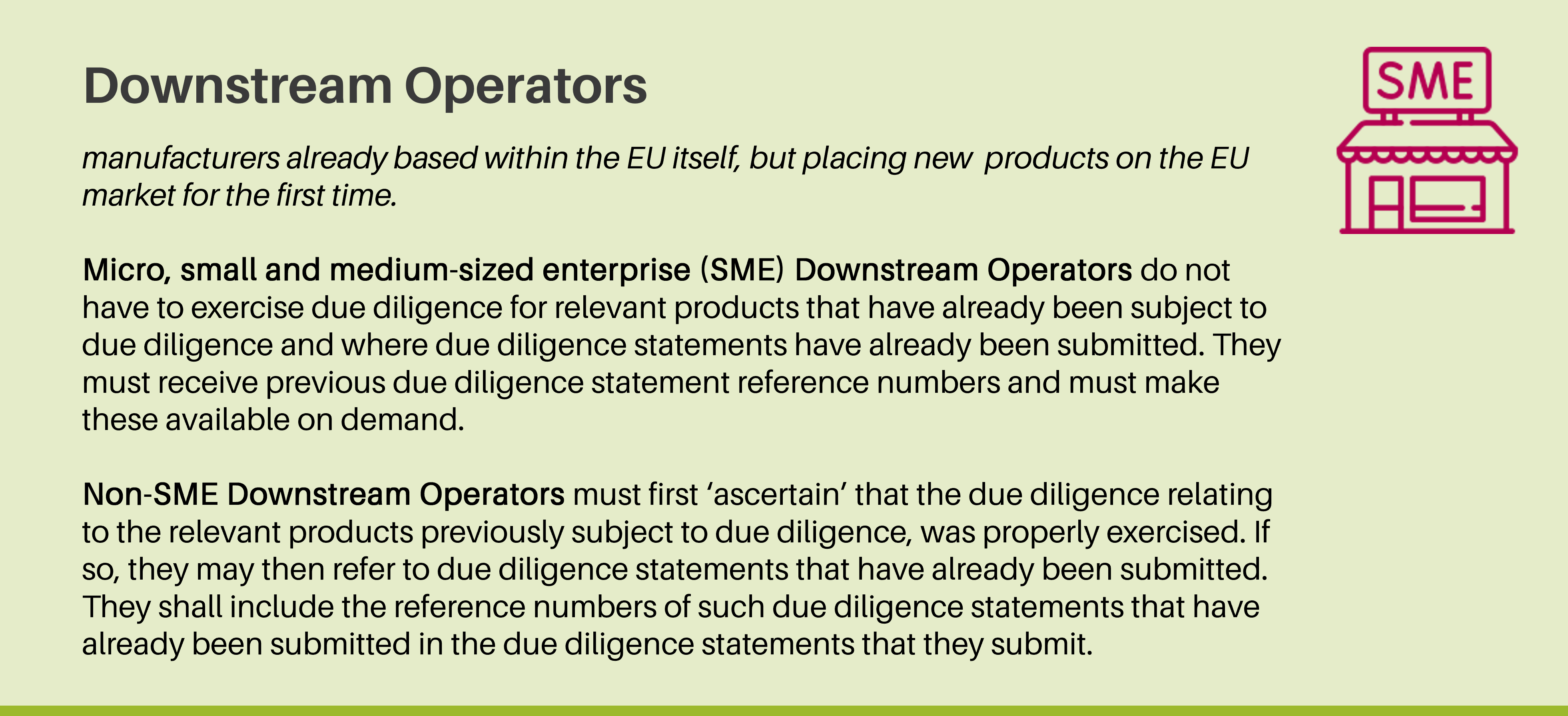

Categories of undertakings: must not exceed the limits of at least two of the three following criteria (large undertakings must exceed the limits of at least two):
Micro-undertakings
| Small undertakings
|
Medium-sized undertakings
| Large undertakings
|
Unsure if the EUDR applies to your company? Use our self-assessment tool, now available in English, French, German and Spanish (more languages coming soon!), to help you determine your obligations under the regulation. As part of our commitment to continuous improvement, we have refined and built upon the initial version to bring you version 2.0 of our self-assessment tool.
>> Access our EUDR scoping tool V2.0
Tracing your products and supply chains
Operators and Non-SME Traders need to gather detailed information and data to be able to demonstrate that their products are deforestation-free and produced in accordance with the legislation of the country of production.
That means knowing exactly where your commodities or products come from – including the geolocation coordinates of all plots of land where they were produced, or harvested in the case of wood and raised in the case of cattle.
For smaller plots, a single latitudinal and longitudinal point will be sufficient. But for plots over 4ha in size, you will need sufficient latitudinal and longitudinal points to describe each plot's perimeter.
A comprehensive central Information System is being developed by the European Commission to efficiently manage Operators' due diligence statements and customs clearance applications, ensuring transparency and ease of compliance.
Disclaimer
The information and guidance presented in this webpage are provided for informational purposes only and do not constitute legal, financial, or professional advice. Preferred by Nature makes no representations or warranties, express or implied, regarding the accuracy, completeness, or suitability of the information contained herein. Preferred by Nature is not liable for the use of guidance contained in this website, nor for any reliance placed on this website or any financial or other loss caused because of reliance on information contained herein.
Any interpretation of the content of this website, or resulting action taken, is at the sole discretion of the reader, in relation to the European Deforestation Regulation or any other legal statute. The entity subject to legal obligations retains full discretion and accountability for compliance with requirements under the law.
Info sheet

EUDR Service Info Sheet
The EU Deforestation Regulation (EUDR) prohibits products and commodities linked with deforestation and forest degradation from being imported into the EU market or exported from ...
The EU Deforestation Regulation (EUDR) prohibits products and commodities linked with deforestation and forest degradation from being imported into the EU market or exported from ...
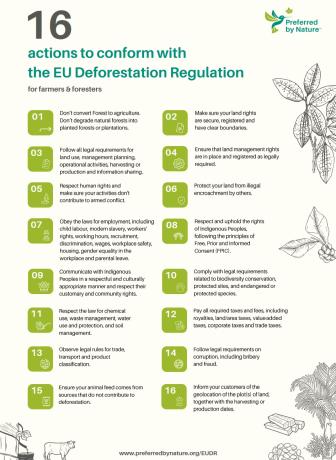
16 actions to conform with the EU Deforestation Regulation
This document outlines actions that farmers and foresters can take to conform with the EU Deforestation Regulation.
This document outlines actions that farmers and foresters can take to conform with the EU Deforestation Regulation.
Template

Guidelines for EUDR Due Diligence System preparation
This document provides clear instructions and practical steps for preparing Due Diligence Systems (DDS) to meet the requirements of the EU Deforestation Regulation (EUDR). It is d...
This document provides clear instructions and practical steps for preparing Due Diligence Systems (DDS) to meet the requirements of the EU Deforestation Regulation (EUDR). It is d...
Preferred by Nature Certification Standards

Preferred by Nature Certification - EU Deforestation Regulation aligned Indicators
To address the EUDR requirements, for agricultural commodities and wood products respectively, we have benchmarked the 157 indicators included in our Sustainability Framework with...
To address the EUDR requirements, for agricultural commodities and wood products respectively, we have benchmarked the 157 indicators included in our Sustainability Framework with...
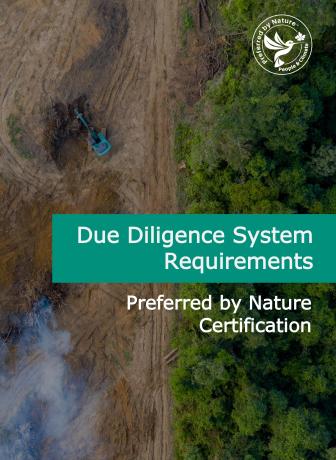
Preferred by Nature Certification - Due Diligence System Requirements
This Standard sets out requirements for organisations that want to demonstrate compliance with the Sustainability Framework for specified products in their supply chains. The Stan...
This Standard sets out requirements for organisations that want to demonstrate compliance with the Sustainability Framework for specified products in their supply chains. The Stan...
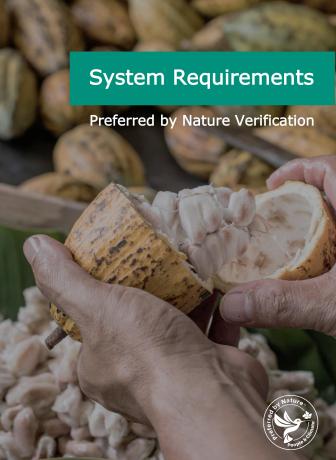
Preferred by Nature Certification - System Requirements V1.4
This document is relevant to all organisations seeking Preferred by Nature Certification, encompassing both land use and supply chain sectors. It outlines the essential requiremen...
This document is relevant to all organisations seeking Preferred by Nature Certification, encompassing both land use and supply chain sectors. It outlines the essential requiremen...
Geospatial Data Sharing Protocol
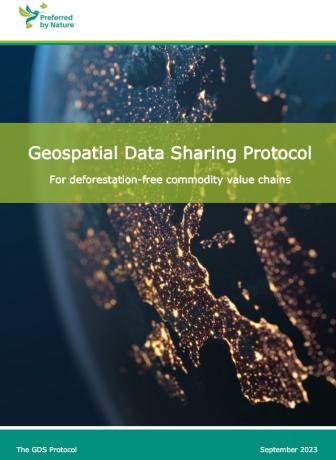
Geospatial Data Sharing Protocol For deforestation-free commodity value chains
The Protocol is intended to be a voluntary standard for providing a uniform means for sharing geospatial data. This will allow organisations to exchange geospatial data efficientl...
The Protocol is intended to be a voluntary standard for providing a uniform means for sharing geospatial data. This will allow organisations to exchange geospatial data efficientl...
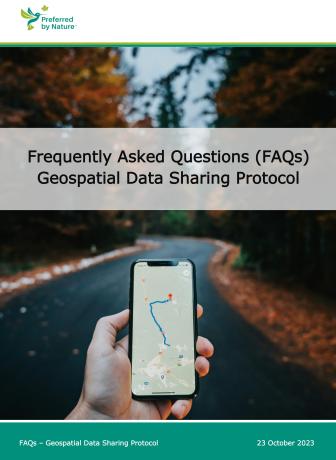
Frequently Asked Questions (FAQs) - Geospatial Data Sharing Protocol
This document outlines all the frequently asked questions related to the Geospatial Data Sharing (GDS) Protocol. It aims to provide clarity and understanding for those interested ...
This document outlines all the frequently asked questions related to the Geospatial Data Sharing (GDS) Protocol. It aims to provide clarity and understanding for those interested ...
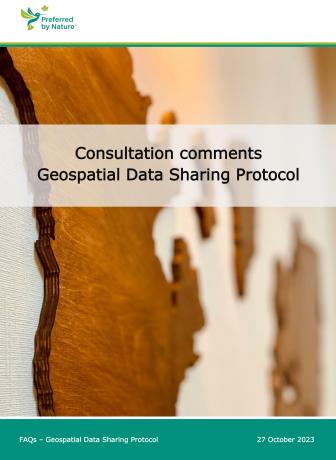
Consultation comments - Geospatial Data Sharing Protocol
The Geospatial Data Sharing (GDS) Protocol's first version was developed in mid-2023 with FAO's support to improve commodity production monitoring. Following expert group input a...
The Geospatial Data Sharing (GDS) Protocol's first version was developed in mid-2023 with FAO's support to improve commodity production monitoring. Following expert group input a...
Videos
Get in contact with us
Our experts are ready to support you on your sustainability journey.

